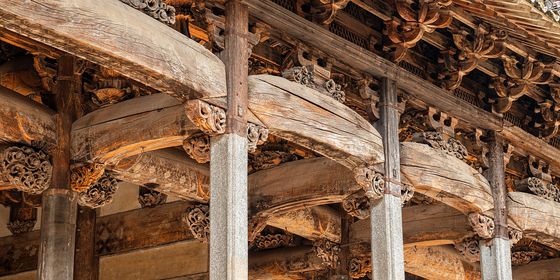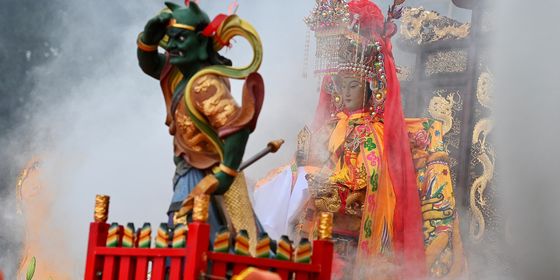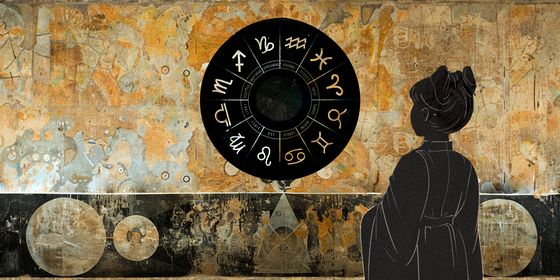A forgotten Silk Road relic sheds light on early Christianity in China
In December of 1906, on the southern edge of the Taklamakan desert, deep in the heart of present-day Xinjiang, archeologist Marc Aurel Stein saw an angel.
The fresco was discovered during an excavation of a Buddhist sanctuary at Miran near Lop Nor, a salt lake in southeast Xinjiang. The image, which had graced a Buddhist stupa, resembled a Christian angel, complete with garlands and feathered wings.
“My surprise was so great that at first, I found it hard to believe my eyes,” Stein wrote in his 1921 work Serindia. “Not here, close to the desolate salt-wastes of Lop Nor, in the ruins of what seems the very last outpost of Buddhist Central Asia towards China, could I have expected to come upon what looked like late classical representations of Cherubim.” Stein visited Miran three times between 1906 and 1914, and found at least eight angels, all of them painted motifs on a dado (the lower interior wall of a temple).
Chinese mythology has many creatures with Western counterparts—vampires that hop and weretigers, to name two—but these were different. “I could not long remain in doubt that the classic influence was far more marked in these frescoes than in any remains of ancient pictorial art which I had so far seen or knew of, whether north or south of the Kun-lun and Hindukush,” Stein wrote in Serindia. He compared the figures to apsaras, female flying spirits in Buddhist mythology, which Stein would later find in abundance at the Mogao Caves at Dunhuang. But the addition of wings and gender-neutral traits to Miran’s flying guardians seemed to evoke Christian icons, and the large eyes and aquiline noses spoke of classical influences.
Other discoveries at Miran gave clues about the origins of the work. A piece of silk, which Stein called “definite palaeographic evidence” for “understand[ing] the purport of what seemed like a loan from early Christian iconography,” proved to be a banner with Kharosthi script. Originating from India, the language died out in the third century in its homeland, but continued to be used until the seventh century along the trade routes in Central Asia. An inscription on one mural at Miran was written in the same language: “This fresco is (the work of) Tita, who has received 3,000 bhatpmakas for it.” Stein deduced the name “Tita” to be an altered form of “Titus,” a popular name in the Roman areas of the Near East and Syria.
These cherubs were one of the most striking examples of cultural exchange on the Silk Road, as well as the oldest: Stein dated the find to no later than the fourth century, well before the first glimpses of Christianity were making their way to the country during the Tang dynasty (618 – 907). The first recognized emissary of Christianity to China, a Nestorian monk named Alopen, is believed to have arrived in 635 in Chang’an (now Xi’an), the capital. In 638, Tang Emperor Taizong (唐太宗) authorized a Nestorian church to be built in the capital with 21 Persian priests and monks, with an edict that seemed to embody the tolerant spirit of the era: “The Way does not have a constant name and sages do not present an unchanging form. They go from place to place establishing their teachings and thereby save all living beings.”
By the end of the Tang dynasty, however, religious devotees of all stripes were fleeing persecution. The famous Nestorian Stele, an eighth-century memorial to Alopen and the first 150 years of Christianity in China, is thought to have been buried during the height of anti-Buddhist campaigned in the mid-800s that also affected Christians, Zoroastrians, and Manicheans in the empire. Miran, too, had existed in contested territory between the Tang, Turkic empires, and Tibetans since the time of Taizong.
A 2013 article in the Chinese Archaeology journal dates the Miran stupas at sometime around the third or fourth century, when a small settlement and monastery flourished there nominally under Tang rule. A Tibetan fort was later established at the same site around the eighth or ninth century, but by the time Stein was visiting, it had been abandoned for more than 1,000 years, and many of its priceless relics had been discarded in trash heaps.
Faced with one of the most fascinating cross-cultural artistic exchanges in history, Stein, in the usual blithe manner of his era’s archeologists, packed off seven relatively intact frescoes to Kashgar and later New Delhi in 1914 (he also excoriated a Japanese expedition that removed an angel in between his second and third visit). A number of them were later sent to the British Museum, and an unknown number are said to still be under the stewardship of India’s National Museum, not exhibited to the public and too fragile to travel. China’s angels seem destined to be lost to history again.
China’s own excavations of Miran began in the late 1970s. In 1989, at least two more “double-winged celestials” were unearthed at temples around the site, as well as in the Silk Road ruin of Loulan the previous year. As China’s ambitions to build new roads across Eurasia get underway, traders will soon be symbolically retreading the roads that the angels once traveled—though nothing, perhaps, can recapture the magic of painted wings peeking out of a millennium of dust, remnant of a cultural crossroads that once flourished at the desert fringes of empires.
City of Angels is a story from our issue, “Vital Signs.” To read the entire issue, become a subscriber and receive the full magazine.













